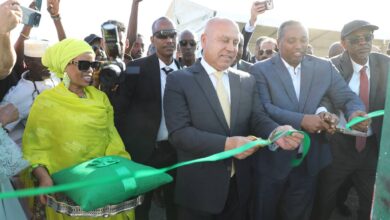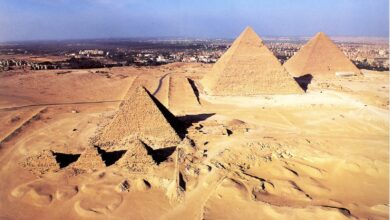The monumental “corridor of development” project proposed by Egyptian-American scientist Farouk El-Baz is still causing a stir within the Egyptian science community, which reiterated its unanimous rejection of the project during a two-day conference held at the Geological Survey premises in Abbasseya on 5 and 6 June.
About 180 of Egypt’s most prominent scientists, experts in agriculture and academics attended the conference on the “development of Egyptian deserts” organized by the newly-created “Eternal Egypt for Science and Development” NGO, and wrote in a collegial process their recommendations in a report that was sent to all the relevant ministries as well as the Supreme Council of Armed Forces (SCAF) today.
Fikri Hassan, the well-respected archeologist and geologist who heads the aforementioned NGO, explained that “this open dialogue was the first of its kind to be organized since Farouk El-Baz’s project was forced upon us [the scientists] in 2005.”
The mega-project consists of a 1200km, eight-lane superhighway in the western desert that would connect El-Alamein on the Mediterranean coast to the Sudanese border. The road will have an integrated railway, a water pipeline and an electric power line, as well as 12 cross-cutting corridors that will link the main north-south corridor to Egypt’s major cities along the Nile. This corridor of development is meant to eliminate the bottleneck the densely-populated Nile Valley by creating communities and cities. El-Baz also insisted on the importance of reclaiming desert land in these areas in order to boost agriculture.
Although the recent two-day conference tackled the broader and more general topic of the development of Egyptian deserts, El-Baz’s project was heatedly discussed and adamantly criticized.
Samer al-Mofty, a renowned Egyptian geologist and former head of the Desert Research Centre in Matareyah, has been voicing his uncompromising rejection of the project for a while now. “The Western Desert is the driest desert on Earth: how can you plan to develop agriculture in such a bleak environment?” he wondered.
Mofty explained that in order to properly irrigate crops, water would need to be either extracted from very deep groundwaters, or pumped from the Nile, a river that he said is already extremely poor in water.
“The Nile has a very low volume of water; between Egypt and Sudan, the river only contains 84 million cubic metres of water.” In comparison, the Amazon river benefits from approximately 6,000 million cubic metres of water. “These projects of cultivating the desert, which are unfortunately already ongoing, are putting extreme pressure on the Nile, and we cannot afford to take Nile water from its bed for the sake of El-Baz’s mega-project.”
Bahi El-Issawi, another well-respected geologist, also disapproves of the agricultural development aspect of the project.
Expressing himself in his distinctive colourful way, Issawi explained that “the Egyptians have always had the dream of cultivating the desert. It is an obsession, but it is never going to happen.”
He explains that the Egyptian deserts will never be cultivated because of the lack of waste disposal systems that are mandatory to flush away the salt deposits formed whenever agricultural activity starts, and which breaks down the soil and eventually makes it useless for cultivation.
“But Farouk El-Baz has changed his mind about cultivating the area of the corridor," he says. "He told me so in a letter that I received a few weeks ago, saying that it was never part of his plan to include agriculture along the corridor.”
Otherwise, Issawi still believes that the proposed area for the corridor should be properly studied for a couple of years by a team of geologists and scientists to try to determine what kind of resources it would be economically viable to extract.
Mofty, during his intervention as part of the conference, declared bluntly, concerning the corridor of development: “Where is the project? Is it a road? A road is not a project, it is just a road, so why would we spend $24 billion on it?”
He explained that the core idea of El-Baz’s corridor is to relieve the overpopulated Nile Valley by creating cities in the desert along the corridor. But what Mofty regrets is that there is no plan in the project for the installation of factories and industries that would hire the displaced work force and attract communities. Instead of having reached deals with companies potentially interested in settling in the desert as part of proper planning, El-Baz is counting on the companies' willingness to relocate to the corridor.
Issawi is less critical, and believes that the desert would be a perfect ground for industries to settle, stopping them from encroaching on Nile Valley agricultural lands. “Companies could be built in the desert, as well as new universities and stadiums,” he explained, pointing out that when the stadium of Medinat Nasr was built in the 1960s, Cairenes felt it was located at the other end of the world.
Sherif Baha al-Din, one of Egypt’s leading conservationists, the creator the Nature Conservation Egypt (NCE) NGO and a specialist in Protected Areas (PA) also attended the conference. He said that he was relieved to discover during the various discussions that “there was a general realization that agriculture is not the most logical development priority in the desert, at least not the traditional type of huge scale agriculture that is extremely wasteful of water."
Fikri Hassan explained that the report he sent to the ministries of housing, environment, transportation, cooperation, finances, industry, higher education, scientific research and water resources, as well as the SCAF, recommends “nodes of development” in locations where there is already a spectrum of resources available that can be easily accessible. The nodes would mix industrial activity and advanced types of agriculture.
Instead of having a corridor of development built from scratch, these nodes would be developed using the pre-existing network of roads that link the various Western Desert oases, and count on the effort of local communities.
Small to medium-scale advanced agricultural methods are envisioned for the needs of the residents of these nodes. "We would install drip irrigation technology, re-use the water cleaned by water-treatment plants, use drought tolerant plants, provide small loans with a guarantee on production, build up cooperatives and use alternative types of energy, mainly solar," Hassan explained.
“We need to invest in research to find ways to enhance the capture, storage, use and transport of solar energy, and if we manage to do so Egypt will become as wealthy in the future as the oil-rich countries are now,” explained Hassan, who is dumbfounded that the Egyptian government is not jumping on the golden opportunity of the “Desertec” project financed by the EU to provide Egypt’s deserts with solar panels.
Baha al-Din insisted that Egypt must have a long-term vision and figure out what the country’s economy is going to be based on in 100 years’ time. “Are we going to be an agricultural country? A country whose economy is based on services, industry? This is something we need to determine in order to launch projects that would be part of this vision.”




